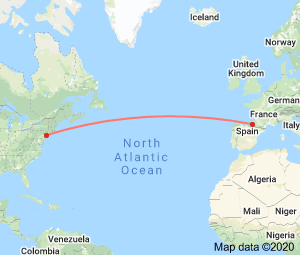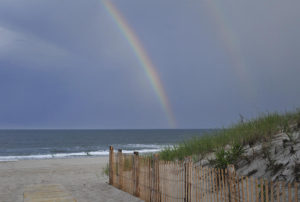 I was born in Bayonne, NJ, and when I was growing up, my family vacationed at the Jersey Shore. My father would stand with me at the water’s edge, the in-coming tide tickling our toes, and tell me that there was another city named Bayonne across the ocean in France. I looked very hard and imagined I could see it, when what I really saw was a ship on the horizon. I wondered about the other Bayonne and dreamed I would visit one day.
I was born in Bayonne, NJ, and when I was growing up, my family vacationed at the Jersey Shore. My father would stand with me at the water’s edge, the in-coming tide tickling our toes, and tell me that there was another city named Bayonne across the ocean in France. I looked very hard and imagined I could see it, when what I really saw was a ship on the horizon. I wondered about the other Bayonne and dreamed I would visit one day.
This summer, thanks to an online course offered through Osher Life Long Learning, I had the opportunity to take a “Tour of France”– virtually. It was interesting and informative and it inspired me to appreciate what I had at home. In the following description I will use MHT (My Home Town) to designate Bayonne, NJ, and CAS (City Across the Sea) for Bayonne, France.
The name Bayonne means “between two waters.” MHT lies between New York Bay on the east and Newark Bay on the west, joined by the Kill Van Kull. In France, Bayonne is located at the confluence of the Nive and Adour Rivers. Both cities have been significant in maritime matters. In France, Bayonne is an inland port near the sea but is protected from the dangers of being directly on the coast. MHT was the site of the Military Ocean Terminal (MOTBY) operated by the US Navy as a logistics and repair base during the Second World War, and has now been converted to Port Liberty, where cruise ships embark for Bermuda and other exotic locations.
Both cities provided economic opportunity for their residents. In MHT there were several industrial plants: Pharma Chemical (Bayer Aspirin), Best Foods (Hellman’s Mayonnaise), and Babcock and Wilcox, manufacturer of steam engines used to power the NYC subway. However the largest employers were the Tidewater and Standard Oil refineries with pipelines connecting them to the oil field of Texas. In France, gas fields were discovered in the Basque region, and the extracted sulfur and associated oil are shipped throughout the world from the port of Bayonne. The two cities have enjoyed a sister city relationship since 1970.
The last time I visited MHT was for a family reunion in 2017. I was happy to see that although there was a different demographic, the city seemed to be thriving. I saw no vacant properties or boarded up buildings. In my virtual tour of the CAS I saw many sights that I could compare to my actual experience.
The Basque Museum: Located in a large 16th century mansion on the river Nive, the museum provides insight into the culture, traditions and history of the region. The Municipal Building in MHT has a portrait of my Father, Stephen F. Sladowski, and a citation attesting to the service he provided to the community displayed in the courtroom.
Atelier Chocolat: The first chocolate ateliers who settled in Bayonne France as Jewish refugees fleeing Spanish expulsion brought their knowledge and skill in chocolate making to the region and established the city’s reputation for exquisite confections. In MHT for several generations, Judicke’s Bakery has provided a variety of tasty treats, especially donuts, for the community to enjoy.
The Cathedral: Cathedral Sainte Marie has been inscribed into the UNESCO World Heritage list as a stop on the St. James Pilgrimage Route to Santiago de Compostela. Pilgrims come to see the shrine of St. Leon, the Bishop of Bayonne credited with converting the Basque Country in the 9th Century, and its beautiful stained glass windows. In MHT, Our Lady of Mount Carmel was our parish church where my husband and I were married in 1960; my parents had been married in 1938; and my grandparents in 1907. It was also the site of our family baptisms and communions. My siblings, cousins and I attended the parochial grammar school.
Grand Bayonne is the oldest part of the city where the best shopping can be found. The pedestrianized Rue d’Espagne has cafes, artisan shops and stores selling Basque regional specialties. A younger vibe and bustling nightlife can be found in the traditionally working class district of Petit Bayonne. The Pont Saint-Espirit connects the two. MHT has an Uptown and a Downtown each with distinct characteristics. Broadway, the main commercial thoroughfare, is lined with retailers, small businesses and professional offices, banks and eateries of every variety. The Bayonne Bridge connects the city to Staten Island, a borough of NYC.
Jardin Botanique.: In the CAS the botanical gardens contain about 1,000 taxa arranged in 11 groupings, including bamboos and a fine collection of Japanese maples, a fountain, waterfall, pond and bridge. It isn’t organized scientifically with plants arranged by species, rather they are chosen and displayed according to their appearance and fragrance. In MHT Hudson County Park was and is one of the city’s premier landmarks, adorned with colorful flower beds, fountains and ponds. There are picnic areas, ball fields, tennis courts, a track for running, and a huge playground for children. The parking area along the bulkhead overlooking Newark Bay serves as the local “lovers’ lane.”
Culinary Delights: In France Bayonne ham has a reputation that travels far outside the country’s borders. Stored under special dry conditions for a minimum of seven months, it is cured, not cooked. Since 1424 the city has paid tribute to this gastronomic favorite with a four day fair during the Easter season when there is traditional music, sport and culinary competitions. MHT: For several generations Petridis hot dogs served plain or with sauerkraut and washed down with a bottle of Yoo-Hoo have thrilled the taste buds of the community, first from a food truck and then a store front café with outdoor dining.
 My curiosity was satisfied by seeing the sites of the City Across the Sea; but my heart was warmed by the memories evoked by My Home Town.
My curiosity was satisfied by seeing the sites of the City Across the Sea; but my heart was warmed by the memories evoked by My Home Town.
Wishing you happy memories and Lots of LovEstelle
What a very interesting comparison and read! Enjoyed the tour! Thanks again for sharing! Ja